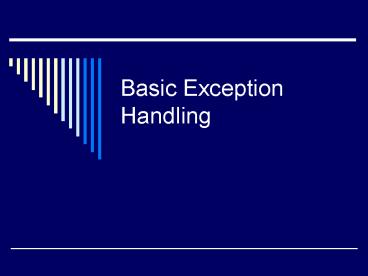Basic Exception Handling - PowerPoint PPT Presentation
Title:
Basic Exception Handling
Description:
This is called throwing an exception. Another part of your code contains code ... way of handling exceptions in Java consists of the try-throw-catch threesome. ... – PowerPoint PPT presentation
Number of Views:29
Avg rating:3.0/5.0
Title: Basic Exception Handling
1
Basic Exception Handling
2
Exceptions in Java
- Either the Java language itself or your code
provides a mechanism that signals when something
unusual happens. - This is called throwing an exception.
- Another part of your code contains code for
handling the exception.
3
Example of Exception Handling
- import java.util.public class GotMilk
public static void main(String args)
int donutCount, milkCount double
donutsPerGlass Scanner keyboard new
Scanner(System.in) System.out.println("E
nter number of donuts") donutCount
keyboard.nextInt( ) System.out.println("E
nter number of glasses of milk")
milkCount keyboard.nextInt( ) if
(milkCount lt 1)
System.out.println("No Milk!")
System.out.println("Go buy some milk.")
else
donutsPerGlass donutCount/(double)milkCount
System.out.println(donutCount "
donuts.") System.out.println(milkCoun
t " glasses of milk.")
System.out.println("You have " donutsPerGlass
" donuts for each glass of
milk.") System.out.println("End
of program.")
4
Example of Exception Handling (contd)
- import java.util.public class
ExceptionDemo public static void
main(String args) int donutCount,
milkCount double donutsPerGlass
Scanner keyboard new Scanner(System.in)
try System.out.println("En
ter number of donuts") donutCount
keyboard.nextInt( )
System.out.println("Enter number of glasses of
milk") milkCount
keyboard.nextInt( ) if (milkCount lt
1) throw new Exception("Exception
No Milk!") donutsPerGlass
donutCount/(double)milkCount
System.out.println(donutCount " donuts.")
System.out.println(milkCount " glasses
of milk.") System.out.println("You
have " donutsPerGlass
" donuts for each glass of milk.")
catch(Exception e)
System.out.println(e.getMessage( ))
System.out.println("Go buy some milk.")
System.out.println("End of program.")
5
How Exception Handling Works
- Exception is a predefined class.
- The throw statement creates an object of the
class Exception and throws it. - When an exception is thrown, the code in the
surrounding try block stops execution, and
another portion of code, know as a catch block,
begins execution. - Execution of the catch block is called catching
the exception.
6
The try Block
- The basic way of handling exceptions in Java
consists of the try-throw-catch threesome. - A try block contains the code for the basic
algorithm that tells the computer what to do when
everything goes smoothly. - It is called try because you are not 100 percent
sure everything will go smoothly.
7
The throw Statement
- If something goes wrong, you want to throw an
exception. - The throw statement creates a new object of the
class Exception and throws it. - When an exception is thrown, the code in the try
block stops execution, and another portion of
code, the catch block, begins execution.
8
The throw Statement (contd)
- In the example,
- new Exception(Exception No Milk!)
- the string Exception No Milk! is an argument
for the constructor for the class Exception. - The Exception object, created with new, stores
this string in an instance variable of the
object, so that it can be recovered in the catch
block.
9
The catch block
- Although it is not a method definition it looks a
little like one. - It is a separate piece of code that is executed
when a program throws an exception. - The throw statement is similar to a method call,
but instead of calling a method, it calls the
catch block.
10
The catch Block Parameter
- The following the word catch is the catch-block
parameter. - The class name preceding the catch-block
parameter specifies what kind of exception the
catch-block can catch. - The catch-block parameter gives you a name for
the exception that is caught, so that you can
write code in the catch block in order to
manipulate that exception object.
11
The getMessage Method
- Every exception has a String instance variable
that contains some message, which typically
identifies the reason for the exception. - If the object is called e, then the method call
e.getMessage() returns this string.































